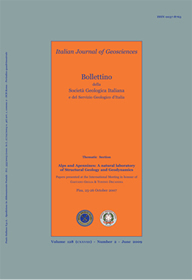
Tectonically-related fluid circulation in the San Casciano dei Bagni-Sarteano area (M. Cetona ridge-Southern Tuscany): a coupled structural and geochemical investigation
Davide Piscopo(*), Marco Gattiglio(**), Elisa Sacchi(***) & Enrico Destefanis(**)
(*) Dipartimento di Scienze Mineralogiche e Petrologiche, Università degli Studi di Torino, Via Valperga Caluso, 35 - 10125 Torino, tel.: +39 0116705107, E-mail address: davide.piscopo@unito.it.
(**) Dipartimento di Scienze della Terra, Università degli Studi di Torino, Via Valperga Caluso, 35 - 10125 Torino.
(***) Dipartimento di Scienze della Terra, Università di Pavia, Via Ferrata, 1 - 27100 Pavia, Italy.
DOI: https://doi.org/10.3301/IJG.2009.128.2.575
Volume: 128 (2009) f.2
Pages: 575-586
Abstract
The aim of this investigation is to examine the relationship between springs and structural setting in the Mt. Cetona Ridge. This area represents an important regional morpho-tectonic feature oriented NNW-SSE, separated from the geothermal area of Monte Amiata to the West by the Radicofani Neogene Basin, and bounded to the East by the Valdichiana Neogene-Quaternary Basin. This Ridge is constituted by the Tuscan Nappe and the overthrusted S. Fiora Unit. New detailed field mapping and a structural study allowed recognition of a polyphase structural setting defined by four folding phases followed by three extensional and transtensional phases.
Coupled to the structural investigation, 13 spring water samples were collected in the area in May and in August 2005. Groundwater ranges from cold, low mineralized calcium-bicarbonate to warm, highly mineralised, calcium sulphate. Results are in general agreement with previous studies indicating the recharge area in the Cetona upland and a circulation in a highly fractured, quasi-continuous reservoir constituted by the Mesozoic limestone and the underlying Burano anhydrite formation. Geochemical modelling indicates that the high variability in the hydrochemical and isotopic composition cannot be explained by a simple binary mixing between two ground-water types, but rather reveals a geochemical evolution involving anhydrite and dolomite dissolution, and calcite precipitation. Outflows are closely related to the structural setting of the area and hydrochemistry allows discrimination of different fluids associated with specific hydrogeological circuits.
The interpretation of the structural setting for Mt. Cetona Ridge was obtained by fieldwork studies integrating geochemical data of both thermal and cold springs. Results of this investigation allow us to propose a new tectonic evolution and fluid circulation model for this area.
Keywords
Get Full Text